Diagnosing dermatologic disorders in dogs
Hundreds of skin diseases affecting domestic dogs have been recognized and reported. Here's how to sort through them.
A new patient, Sweet Pea, a 6-year-old 55-lb (25-kg) spayed female tan-and-white bulldog, is brought in for an evaluation because of a history of pruritus. The client reports that Sweet Pea has been scratching intermittently for the past three years, while her ears have been pruritic consistently for the past year. The client says Sweet Pea begins by scratching her ventral trunk, developing skin lesions that then progress to whole-body pruritus.
No other pets are in the household, and people in the household have no skin lesions. Sweet Pea spends most of her time indoors and goes outside to a rock-covered backyard. During the past 12 months, she has been treated with essential fatty acid supplementation, tea-tree and oatmeal-based shampoos, antihistamines, oral and topical corticosteroids and holistic vitamin supplements.

Photo 1:
Sweet Pea at presentation. Note the erythema.
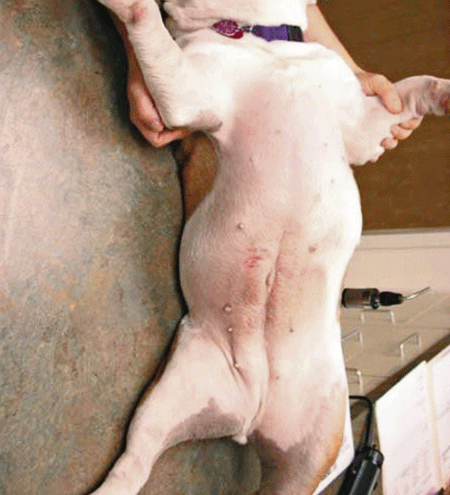
Photo 2:
Maculopapular dermatitis of Sweet Pea's axillae and sternum at presentation.
Physical examination shows nearly generalized erythema, maculopapular dermatitis of the sternum and axillae, focal lichenification and excessive interdigital keratosebaceous debris with erythema, salivary staining, moderate skin thickening and malodor (Photos 1-3). Are these signs of an allergy (i.e., environmental, food or parasite hypersensitivity), an endocrine disorder, a behavioral problem or a combination of several disorders?
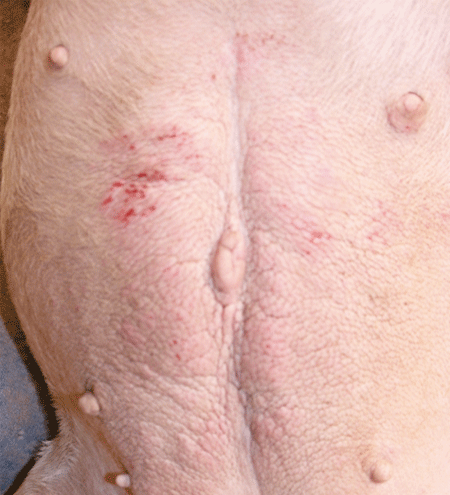
Photo 3:
Close-up view of the maculopapular dermatitis of Sweet Pea's axillae and sternum at presentation.
Diagnostic protocol
Hundreds of skin diseases affecting domestic dogs have been recognized and reported. Distinguishing among these disorders can be a daunting task for a beginning dermatology resident, as well as a busy general practitioner. The first thing to know: Most patients presenting with a dermatologic disorder are afflicted with either an allergy- or endocrine-related disease.
With careful questioning of the client, a thorough physical examination of the patient and appropriate clinical testing, you can obtain a complete and accurate diagnosis quickly and cost-effectively, followed by improved patient care. The summation of your findings should lead to an accurate diagnosis. The following protocol is suggested to help distinguish allergic from endocrine patients.
1. Identify the signalment
Always consider the age of onset when developing a list of differential diagnoses for a cutaneous condition. In general, allergic disease begins in young to middle-aged dogs, whereas most patients with an endocrinopathy may be somewhat older (Table 1). Most atopic dogs first show clinical signs between the ages of 1 and 5 years. Although any dog may become atopic, certain breeds have a higher incidence, including most retrievers and terriers, Lhasa apsos, Shih Tzus, cocker spaniels, Irish setters, German shepherds and English bulldogs. Food allergy and parasite hypersensitivities (e.g., fleas, Sarcoptes or Cheyletiella species) can and will occur at any age and in any breed.
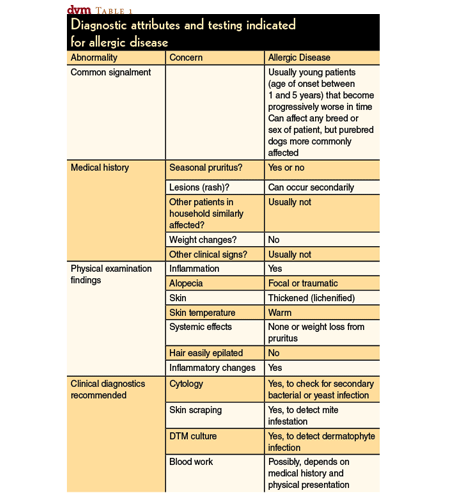
2. Define what qualifies as a thorough history
When you develop a standardized medical history questionnaire and then use it consistently in your veterinary practice, important historical pieces of information are much less likely to be missed or overlooked. Important questions to have your medical team discuss with the client include the following:
• How long has the problem been present? In general, patients with atopy or inhalant allergies tend to start scratching in an early phase of life and then become progressively worse each allergy season. Food and flea allergies can develop at any point in life. In some regions of the country, flea allergies are seasonal.
• Is pruritus a significant problem for the patient? The primary concern of most clients of allergy patients is scratching, licking, chewing and discomfort. Owners often equate a successful treatment with the cessation of pruritus. Team members should specifically discuss if the pruritus is seasonal or year-round, where the pruritus predominantly occurs (e.g., head and neck, sides and interdigital region) and how often the patient truly is scratching. Just as pain thresholds vary from one patient to the next, so do pruritus thresholds.
• Do clients note a rash with the pruritus, and, if so, did the pruritus occur before or after the development of lesions? A rash that develops before pruritus may be due to infectious, parasitic or immune-mediated causes, whereas allergic patients often scratch first and develop a secondary infection with associated lesions.
• Are people or other household dogs affected? In households with multiple patients suffering from dermatologic disease, contagious causes should be explored. Specifically fleas, sarcoptic mange, cheyletiellosis and dermatophytosis should be definitively ruled out. Because these mites can be difficult to find on skin scrapings, it's recommended in any case in which parasites are suspected that patients be treated for mites.
• Has the patient recently gained or lost weight? Sudden or even gradual changes in weight could signal a primary underlying condition other than allergy. For example, weight gain, despite calorie control and exercise, can be a sign of endocrine disorders such as hypothyroidism or hyperadrenocorticism.
• What about current and recently administered medications? This is important: Encourage owners to bring all medications the patient was given recently. Knowledge of how long the medications were given and how effective the medications were can provide useful clues to the underlying cause.
• Are there physical signs suggesting other systemic disease? Change in appetite, increase in water consumption or urination or exercise intolerance may suggest other underlying diseases or disorders, as can as a patient seeking or avoiding heat.
• What's the patient's medical history? Encourage clients to bring in past medical records so you can fully review all past diagnostics and therapies and the success or failure of those therapies.
3. Perform a physical examination
Before the detailed dermatologic examination, perform a complete general physical examination, paying particular attention to the patient's overall body condition. Always perform thoracic auscultation and abdominal palpation.
One of the most helpful factors in distinguishing hypersensitivity conditions from endocrine disorders is the presence of inflammation. A patient with allergic disease will generally have inflamed skin that, by definition, results in pruritus, erythema and warm skin. Sites usually affected by atopic dermatitis include the pinnae, feet, medial brachial region and the inguinal, axillary and perineal areas.
Flea allergy classically affects the dorsal caudal trunk, and food allergy often affects the head and perineal areas (i.e., ears and rears). These patterns can be helpful diagnostic clues, although they certainly are not foolproof or diagnostic alone. With time, an allergic patient may develop signs of chronicity, including induration and lichenification (thickening) of the skin with postinflammatory hyperpigmentation that is sometimes referred to as elephant skin. Alopecia may be present, but it's more likely to be focal or asymmetric and associated with traumatic removal (barbered and excoriated) or due to folliculitis, such as secondary pyoderma.
As noted, individual patients can have different pain and itch thresholds. Some allergic dogs with high pain thresholds can present with very erythematous skin and not exhibit any discomfort until they develop a secondary pyoderma. Both allergies and endocrine disease often lead to secondary infections, which pose one of the greater challenges in working up a patient, since most dogs infected with Staphylococcus or Malassezia species will be pruritic. Although most patients with an endocrine disease won't be pruritic, they are susceptible to these infections, which can cause pruritus. As stated previously, it's helpful to know from the history if the lesions preceded the pruritus, as that would indicate the infection caused the itch. In this situation, we find it helpful to treat the infections appropriately and determine what level of pruritus remains. If all of the pruritus has resolved, with no evidence of cutaneous inflammation (e.g., erythema), then screening for underlying endocrine disorders is appropriate. Another advantage of clearing the infection before screening for endocrinopathies is to minimize the confusion between sick euthyroid syndrome and true hypothyroidism.
While examining the skin, look for primary or secondary lesions such as papules, pustules, erythema, alopecia or crusts (Photos 4 & 5).

Photo 4: Macules, papules, crust and collarettes on a dog.
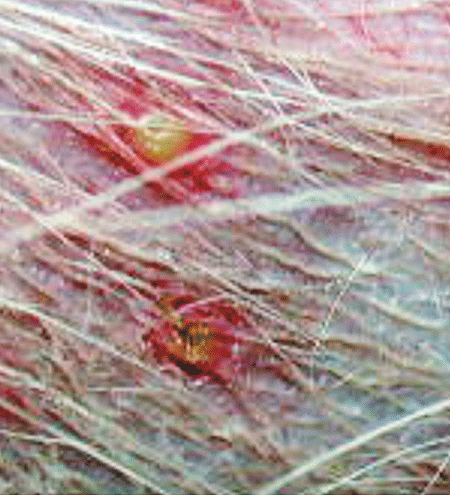
Photo 5: A pustule on a dog.Don't overlook disorders such as dermatophytosis, demodicosis and pemphigus foliaceus when these lesions are present. Don't assume the lesion to be caused by Staphylococcus species. Use cytology to help make this determination (Photo 6).
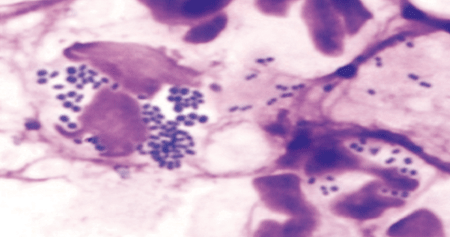
Photo 6: Results of a cytologic examination revealing an intercellular coccoid bacteria. Also note the ease of hair epilation (which could signal an endocrinopathy) and any evidence of chronicity, such as lichenification and induration of the skin (Photo 7). If the skin exhibits excessive keratosebaceous debris (greasy) within skin folds, then Malassezia dermatitis also should be suspected. Malassezia dermatitis also can cause dry lesional changes (e.g., scaly plaques) or erythema without other changes.
Allergic patients usually won't show internal manifestations or systemic signs such as changes in weight, exercise tolerance, hunger or thirst. One exception: Patients with a food allergy may suffer from periodic vomiting, diarrhea, flatulence or frequent bowel movements. Allergic dogs usually have no abnormalities on blood work, except for the occasional hypereosinophilia or sick euthyroid patient.
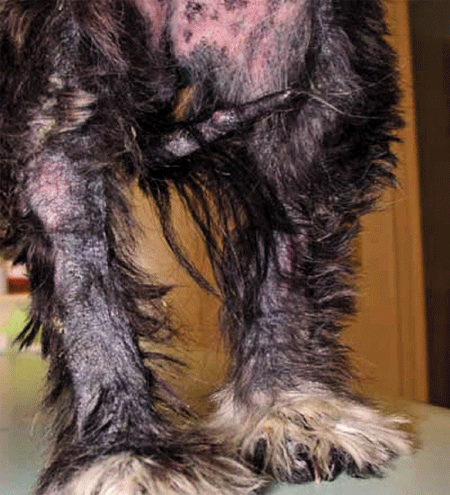
Photo 7: A dog with marked hair loss. 4. Perform clinical diagnostics.
After obtaining a history and performing a physical examination, formulate and present to the owner a diagnostic workup to obtain conclusive answers. If the medical history and physical examination of the lesions suggest allergic disease, then likely skin scrapings, cytology and dermatophyte test medium (DTM) cultures are indicated. The following is a general overview for each diagnostic method:
Cytology: Any animal that's pruritic, malodorous or scaly or that presents with patches of alopecia and crust should be evaluated for bacterial and yeast infections with cytology of the skin surface (Photos 8 & 9). Secondary yeast and bacterial infections are a common reason we see allergic animals with uncontrolled pruritus where the owners claim sudden progression from mildly itchy to severe pruritus. Since secondary bacterial and yeast infection treatments are very different, it's imperative to know which one, if not both, the patient has.
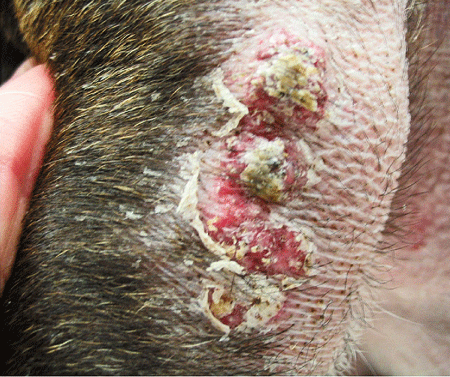
Photo 8: A dog with crusts, indicating the need for bacterial and yeast infection evaluation.
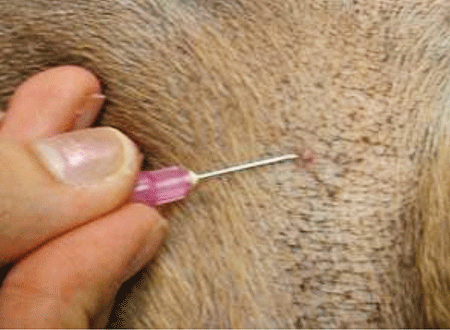
Photo 9: Obtaining a sample for cytologic examination for bacteria or yeast.
Skin scraping: The skin of any pruritic or flaky-skinned dog (or cat) should be scraped for superficial and deep mites (Photos 10 & 11).
This, along with cytology, should be part of the minimum database for any animal presented for dermatologic problems.
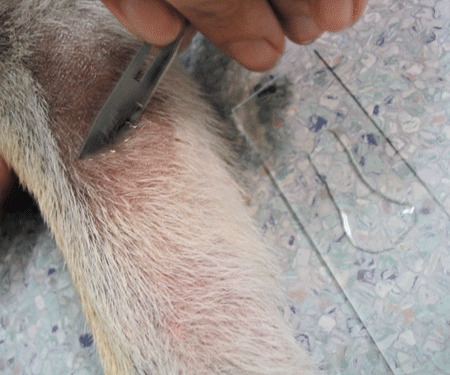
Photo 10:
Obtaining a skin scraping sample.
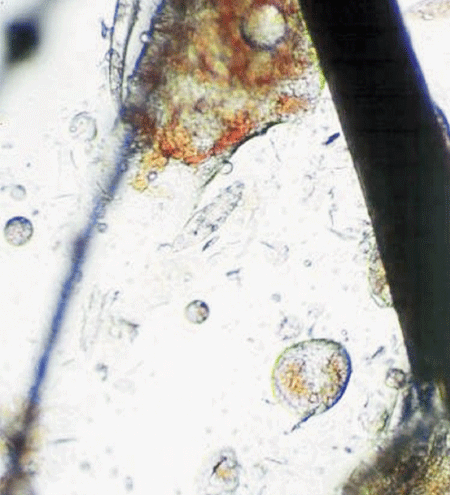
Photo 11:
Cytologic example of a skin scraping.
• Fungal culture:
The gold standard for diagnosing dermatophytosis is the Mackenzie toothbrush test in which a new toothbrush is used to brush suspected areas (or the entire animal in asymptomatic animals). The brush is then gently impressed onto the fungal media (Photo 12). Hairs also may be collected from lesions and embedded into the media. DTM is the recommended fungal medium because it contains a pH indicator.
Obtain cultures on flat plates, which make it easier both to inoculate the media with the toothbrush and obtain samples when making microscopic identification. Many products also contain a second agar or fungal medium with either Sabouraud's dextrose or a rapidly sporulating medium that can easily grow the diagnostic macroconidia used for identification. The plates should be cultured in the dark at 30 percent humidity and 86 F (30 C) and then observed daily for 14 to 21 days.

Photo 12:
Application of the brush onto the fungal media for a dermatophyte culture.Dermatophyte colonies usually are white to buff-colored and will never be darkly pigmented (Photo 13). Nondermatophyte or contaminate (saprophytic) fungi often are darkly pigmented and rapidly growing (like bread mold). All dermatophytes initially metabolize or consume protein within the DTM, and the resulting metabolites change the pH. The pH indicator in DTM then causes the red color change. Other fungi and molds initially consume carbohydrates within the medium but may be able to convert to protein metabolism when the carbohydrates are depleted. That's why, if given enough time, even nondermatophyte fungi can cause a color change of the medium. For this reason, the plate should be observed every day so the color change can be correlated with fungal growth. Dermatophyte identification can be completed by microscopic examination of the spores. Collect spores by gently touching clear scotch tape to the colony, and then place the tape on a slide over one to two drops of lactophenol blue or blue stain.
If mites are found on skin scrapings, microorganisms are found on cytology or dermatophytes are grown on DTM, then appropriate therapy should be instituted. Reevaluate the patient after adequate treatment.
If the patient presents with signs of inflammatory skin disease, and in-house testing rules out parasites and infections, then an allergy workup is indicated. If the patient has seasonal pruritus, then consider atopy, flea allergy or both. If the patient's pruritus is nonseasonal or if the clinician and client are unsure, then initiate a food trial and a parasite treatment trial to rule out
Sarcoptes
and
Cheyletiella
species infestation. For the food trial, ask the client to use a novel protein and carbohydrate different from any previously fed protein in either the animal's food or treats.
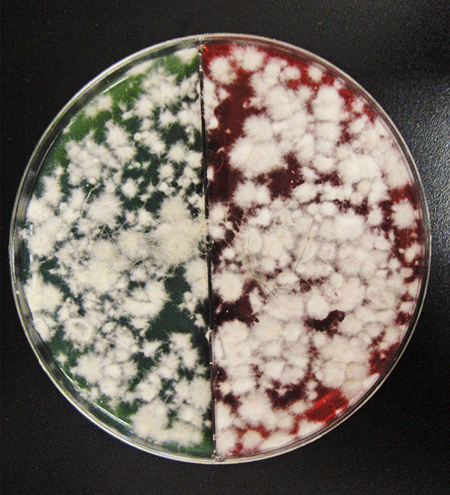
Photo 13:
Dermatophyte colonies on fungal media.
Sweet Pea's outcome
Applying the above-noted protocol to Sweet Pea, we recognized that the ventral lesions required further diagnostic testing to determine their cause. Skin scraping results were negative, but cytology of both an intact pustule and surface debris revealed coccoid bacteria phagocytized by neutrophils. Malassezia species was not present. The history of waxing and waning pruritus was consistent with a diagnosis of atopy, but it was unclear if the year-round ear pruritus was due to the atopy, infection or concurrent food hypersensitivity.
Sweet Pea was treated with cephalexin for three weeks and a six-week hypoallergenic diet trial of rabbit and potato. At the follow-up examination six weeks later, the lesions had cleared, but Sweet Pea remained pruritic. We concluded the pyoderma was due to the atopy and discussed with the client the multiple options available for management of atopic dermatitis.
In summary, identification and care of the allergic patient requires close attention to medical history, physical examination findings, identification of secondary infection and proper treatment modalities. It's up to the medical team to isolate the clinical signs that detect aspects of allergy and help the client understand the importance of proper identification and clinical diagnostics, so treatment expectations are realistic.
SUGGESTED READING
• Scott D, Miller W, Griffin C. Muller and Kirk's small animal dermatology. Baltimore, Md: Elsevier-Saunders, 2000.
• Feldman E, Nelson R. Canine and feline endocrinology and reproduction. 3rd ed. Baltimore, Md: Elsevier-Saunders, 2003.
• Rosenfeld AJ. Veterinary medical team handbook. Ames, IA: Wiley-Blackwell, 2007.
Dr. Lewis sees dermatology patients in California, Arizona, Nebraska, New Mexico, Nevada and Utah. In 1991, he established Dermatology for Animals, PC. Dr. Rosenfeld is the founder and president of VTEC. He has practiced small-animal critical care and emergency medicine for 20 years and is currently working as a general practitioner and running a mobile ultrasound practice in Cape Cod, Mass.
For a visual diagnosis quiz, click here.